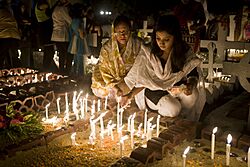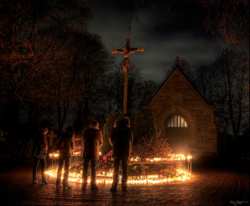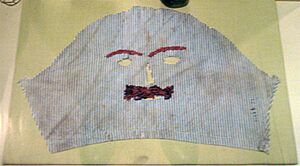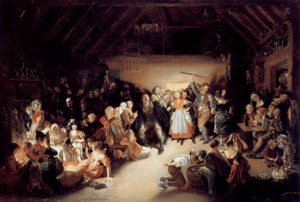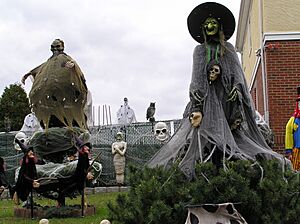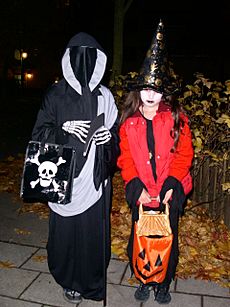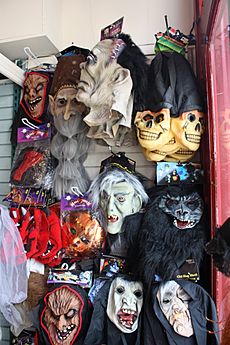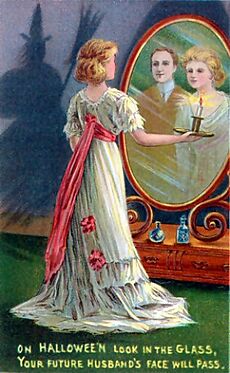Halloween facts for kids
Quick facts for kids Halloween |
|
|---|---|
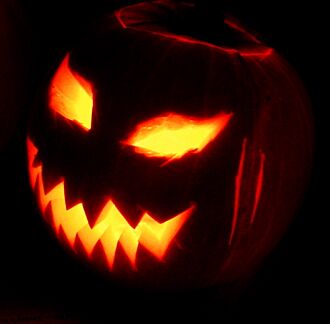
A jack-o'-lantern, a carved pumpkin that is a famous Halloween tradition.
|
|
| Also called |
|
| Observed by | Western Christians and many non-Christians around the world |
| Type | Christian, cultural |
| Significance | First day of Allhallowtide |
| Celebrations | Trick-or-treating, costume parties, making jack-o'-lanterns, lighting bonfires, divination, apple bobbing, visiting haunted attractions |
| Observances | Church services, prayer, fasting, vigil |
| Date | 31 October |
| Frequency | Annual |
| Related to | Samhain, Hop-tu-Naa, Calan Gaeaf, Allantide, Day of the Dead, All Saints' Day, St. Martin's Day, Reformation Day, Mischief Night (cf. vigil) |
Halloween is a fun holiday celebrated in many countries on October 31. It is the evening before the Christian holiday of All Hallows' Day. Halloween marks the beginning of Allhallowtide, a time for Christians to remember the dead, including saints and loved ones. Today, many people know Halloween as a time for spooky fun, costumes, and candy.
Some believe that Halloween's traditions came from ancient Celtic harvest festivals, like the Gaelic festival of Samhain. These festivals had pagan roots. Others think Halloween started as a purely Christian holiday. For centuries, Irish and Scottish immigrants brought their Halloween customs to North America. From there, American culture helped spread Halloween traditions around the world.
Popular Halloween activities include trick-or-treating, going to costume parties, and carving pumpkins into jack-o'-lanterns. People also light bonfires, play games like apple bobbing, visit haunted attractions, tell scary stories, and watch horror movies. For some Christians, it is a religious evening involving church services and prayer.
Contents
What Does "Halloween" Mean?
The word Halloween or Hallowe'en has Christian roots. It is a short way of saying "All Hallows' Eve," which means the evening before All Hallows' Day (or All Saints' Day). In the Scottish language, the word for "evening" is even, which was shortened to e'en. So, (All) Hallow(s) E(v)en became Hallowe'en.
History of Halloween
Christian Roots and Old Customs
Halloween is linked to Christian traditions. It is the evening before All Hallows' Day on November 1 and All Souls' Day on November 2. These three days together are called Allhallowtide. During this time, Christians honor saints and pray for the souls of people who have recently died.
In the 8th century, Pope Gregory III moved a feast day honoring all saints to November 1. Some say this was done to replace or Christianize an older pagan festival. By the 12th century, it became a holy day of obligation in Western Europe. Traditions included ringing church bells for the souls in purgatory and sharing soul cakes.
The custom of "souling," where poor people and children went door-to-door collecting soul cakes for praying for the dead, might be the origin of trick-or-treating. People also carried lanterns made from hollowed-out turnips. These were the first jack-o'-lanterns and were meant to represent souls or scare away evil spirits.
Wearing costumes might come from the belief that ghosts roamed the Earth on Halloween. People wore masks and costumes to avoid being recognized by any vengeful spirits. In some parts of Europe, people believed the dead rose for a "hideous carnival" called the danse macabre (dance of death), which may have inspired costume parties.
Gaelic and Celtic Influences
Many of today's Halloween customs are also thought to come from folk traditions in Celtic-speaking countries like Ireland and Scotland. These are often linked to the Gaelic festival of Samhain (pronounced "SAH-win").
Samhain was celebrated on October 31 and November 1. It marked the end of the harvest and the beginning of winter, or the "darker half" of the year. The Celts believed that on this night, the border between our world and the Otherworld was very thin. This meant spirits and fairies (the Aos Sí) could easily cross over.
To keep these spirits happy, people would leave out offerings of food and drink. They also believed the souls of dead relatives would visit, so they would set a place for them at the dinner table.
Festivities also included games to predict the future, especially about marriage and death. People used apples and nuts for these games. They also lit large bonfires, which were thought to have protective powers. People would carry torches from the bonfire around their homes and fields to protect them.
From at least the 16th century, people in Ireland and Scotland practiced "guising." This involved going from house to house in costume, reciting songs or verses in exchange for food. This may have been a way to imitate the spirits and receive offerings on their behalf. Wearing a disguise was also thought to protect you from them.
Halloween Comes to North America
When Irish and Scottish immigrants moved to North America in the 19th century, they brought their Halloween traditions with them. At first, these customs were only celebrated within their communities. Over time, they blended into mainstream American culture.
By the early 20th century, Halloween was celebrated across the United States by people from all backgrounds. Through American influence, Halloween customs then spread to many other countries around the world.
Famous Halloween Symbols
Halloween symbols have developed over many years. Jack-o'-lanterns are one of the most famous. According to an Irish folktale, they are named after a man named Stingy Jack. Jack tricked the Devil and was not allowed into Heaven or Hell. He was forced to roam the Earth with only a burning coal inside a hollowed-out turnip to light his way.
In Ireland and Scotland, people traditionally carved turnips. When immigrants came to North America, they found that pumpkins were much larger and easier to carve. This is why pumpkins are so popular for jack-o'-lanterns today.
Modern Halloween imagery is also inspired by classic horror stories like Frankenstein and Dracula, as well as horror movies. Skulls are a common symbol, reminding people of death. Other popular symbols include ghosts, witches, black cats, and scarecrows. The traditional colors of Halloween are black, orange, and sometimes purple.
Fun Halloween Activities
Trick-or-Treating
Trick-or-treating is a favorite Halloween tradition for children. Kids dress up in costumes and go from house to house, saying "Trick or treat?" to ask for candy. The "trick" is a playful threat to pull a prank if no treat is given. This custom is related to the old practices of souling and guising.
The phrase "trick or treat" first appeared in print in 1927 in Canada. The practice became very popular in North America in the 1930s. A newer version is "trunk-or-treating," where kids get treats from decorated car trunks in a safe place like a church or school parking lot.
Wearing Costumes
Halloween costumes were originally modeled after spooky figures like vampires, ghosts, and witches. Today, you can see costumes of all kinds, from superheroes and princesses to movie characters and celebrities.
Dressing up in costumes, or "guising," was common in Scotland and Ireland by the late 19th century. It became popular in the U.S. in the early 20th century for both adults and children.
Some people also dress up their pets for Halloween. The most popular pet costumes are pumpkins, hot dogs, and bumblebees.
Games and Other Fun
Many traditional Halloween games started as ways to tell the future. Today, they are just for fun.
- Apple bobbing: Players try to grab an apple from a tub of water using only their teeth.
- Fortune-telling: In one old game, a person would peel an apple in one long strip. They would then toss the peel over their shoulder. The shape it landed in was said to be the first initial of their future spouse.
- Food with hidden items: In Ireland, a special fruitcake called barmbrack is eaten. A ring and other charms are baked inside. Finding the ring is said to mean you will get married soon.
Telling ghost stories and watching scary movies are also popular activities at Halloween parties. Many TV shows air special Halloween episodes for families to enjoy.
Haunted Attractions
Haunted attractions are places designed to thrill and scare people. These are often seasonal businesses that open for Halloween. They can include haunted houses, corn mazes, and spooky hayrides.
The idea of haunted houses became popular in the U.S. in the 1930s. The first major haunted attraction was The Haunted Mansion at Disneyland, which opened in 1969. Today, many theme parks around the world, like Universal Studios, host huge Halloween events. These events have helped make Halloween popular globally.
Halloween Food
Since Halloween falls during the autumn apple harvest in the Northern Hemisphere, apple treats are very popular.
- Candy apples (or toffee apples) are whole apples covered in a hard sugar coating.
- Caramel apples are covered in soft caramel and sometimes rolled in nuts.
Another famous Halloween treat is candy corn, a small, triangle-shaped candy that looks like a kernel of corn. In Ireland, a cake called a barmbrack is a traditional Halloween food. It is a fruitcake with a ring and other small items baked inside. Finding an item is considered good luck. Many companies also make special Halloween-themed candies and cakes decorated with pumpkins, ghosts, and spiders.
Religious Views on Halloween
Christian attitudes toward Halloween are different around the world. Some churches focus on the Christian origins of the holiday. They hold services, prayers, and vigils on All Hallows' Eve. Some churches host "Light Parties" to focus on Jesus as the "Light of the World."
Other Christians, especially some Protestants, celebrate Reformation Day on October 31. This day remembers the start of the Protestant Reformation. They may host "Harvest Festivals" or "Hallelujah Nights" where children dress up as Bible characters.
Some Christians are concerned about Halloween's connection to paganism or the occult. However, many churches see it as a fun, harmless event for kids. They host parties where children can dress up, play games, and get free candy in a safe environment.
Halloween Around the World
The way Halloween is celebrated varies from country to country.
- In Scotland and Ireland, traditional customs like guising, parties, and bonfires are still popular.
- In the United States and Canada, Halloween is a major holiday with trick-or-treating, elaborate decorations, and big parties.
- Thanks to North American influence, Halloween is now celebrated in many other places, including Brazil, Australia, New Zealand, Japan, and much of Europe.
Cool Facts About Halloween
- The English word 'Halloween' comes from "All Hallows' Eve." This was the evening before the Christian holidays of All Hallows' Day (All Saints' Day) on November 1st and All Souls' Day on November 2nd.
- The Christian custom of baking and sharing soul cakes for all christened souls, known as 'souling,' might be the start of trick-or-treating.
- Most American Halloween traditions came from Irish and Scottish immigrants.
- Trick-or-treating wasn't a common practice in North America until the 1930s.
- Trunk-or-treating is a popular way to trick-or-treat now. Children get treats from car trunks parked in places like church or school parking lots.
- The yearly New York's Village Halloween Parade is the biggest Halloween parade in the world! More than 60,000 people in costumes join in, and two million people watch it. It's even shown on TV around the world.
- The American tradition of carving pumpkins was first linked to harvest time in general. It didn't become specifically tied to Halloween until the mid-to-late 1800s.
- In 2018, a report said that 30 million Americans were expected to spend about $480 million on Halloween costumes for their pets! The most popular pet costumes were the pumpkin, followed by the hot dog, and then the bumblebee.
See also
 In Spanish: Halloween para niños
In Spanish: Halloween para niños


